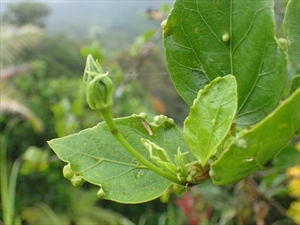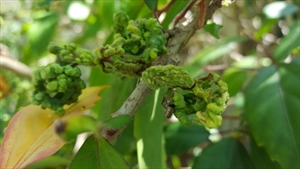- Distribution not well known. Caribbean, Brazil, Oceania. On ornamental Hibiscus and okra. A major pest affecting appearance.
- Mites live in the buds where feeding stimulates bumpy light green galls on leaves, petioles and young stems. Gall surface has felt-like hairs.
- Spread in wind, on cuttings, birds and insects.
- Natural enemies: predatory mites.
- Cultural control: healthy cuttings; prune mite-affected parts; tolerant varieties.
- Chemical control: PDPs: garlic or derris; or sulphur, white oil, or abamectin. Note predatory mites will be killed by application of pesticides.
Pacific Pests, Pathogens and Weeds - Online edition
Pacific Pests, Pathogens, Weeds & Pesticides
Hibiscus mite (266)
Hibiscus mite, hibiscus erineum mite, hibiscus leaf-crumpling mite. The word 'erineum' is a botanical term meaning tuft of hairs. This describes the felt-like appearance of the galls.
AUTHOR Grahame Jackson
Information from Hara A, et al. (2001) Hibiscus erineum mite. Cooperative Extension Service, College of Tropical Agriculture & Human Resources, University of Hawaii at Manoa; and Green C, Gough N (2000) Hibiscus erinose mite. Centre for Amenity and Environmental Horticulture, Department of Primary Industries, Cleveland, Queensland. (http://www.hibiscusworld.com/pests/Erinose.htm). Photos 1-3 Richard Markham, ACIAR, Canberra. Photos 4-6 Frank Visser, Key Industries, New Zealand.
Produced with support from the Australian Centre for International Agricultural Research under project PC/2010/090: Strengthening integrated crop management research in the Pacific Islands in support of sustainable intensification of high-value crop production, implemented by the University of Queensland and the Secretariat of the Pacific Community.









